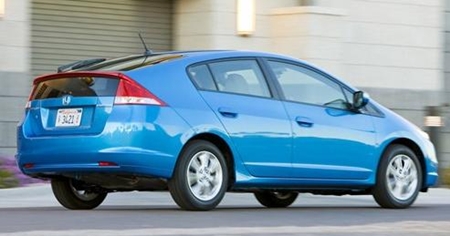I spoke with an oil exploration engineer and asked him directly if we are really running out of oil. “Yes, definitely!” was his initial response, but later in the conversation admitted that perhaps the real situation was that we were running out of the oil that could be extracted at a reasonable price. It seems that new oil field deposits are too deep or too difficult or too expensive – currently.
In 2010 the “Future of Electric Vehicles” conference took place in San Jose, California. This was an all-inclusive look at EVs, incorporating all forms of electric vehicles – land, water, and air, and covered new emerging technologies.
 Electric Roadster.
Electric Roadster.
At the conference it was pointed out that cars make up only about half the market for EVs, even though Nissan and Tesla produce the initial mainstream EVs. The rest of the EV market covers two-wheelers such as scooters and e-bikes constituting a significant portion of the other half.
It was predicted that about 5 to 18 percent of cars will be pure electric or hybrid by 2020.
It was also admitted that some aspects of the EV technology were not new, such as Dr. Ferdinand Porsche’s ‘in-wheel’ electric motors (and the battery charge being continually topped up by an on-board internal combustion engine).
The conference agreed that practical electric cars are going to remain small in size for years to come as the batteries required to power a larger vehicle will simply be too large and heavy.
However, this prediction is not necessarily shared by everyone, with the battery technology revolution turning out smaller, lighter and more powerful batteries every day. One only has to hearken back to the batteries needed for the first mobile phones which required a suitcase and the carrier to have gone to Thor’s gymnasium, and then compare them to the iPhone battery of today.
The public’s range fear is a real one, and the opinion was expressed that electric cars will require some sort of range-extending capability before they will ever achieve mainstream acceptance. This is undoubtedly true, with ranges generally under 100 km, making them city commuters only, other than notable examples such as the Tesla roadster.
Range and charging time were the subjects of a research, and of those respondents who were likely to buy an EV, two thirds expected a range between 500 and 650 km.
 Honda Insight – or out of sight?
Honda Insight – or out of sight?
Acceptable charge times for 70 percent of the group likely to buy expected times between four to eight hours, but almost all would pay a premium to enjoy faster recharging times.
Batteries have high energy density but they must be greatly oversized in today’s hybrid vehicles to avoid deep discharges. Battery-only hybrids also require a powerful internal combustion engine for hill climbing and acceleration.
Despite all the touted advances in the development of practical electric cars, would you actually buy one? Zpryme Research and Consulting recently conducted a web-based survey of 1,046 men and women across the U.S., asking how they felt about various aspects of buying an EV.
Only 8.5 percent of respondents said they were very likely to buy an EV within the next two years, although 28.7 percent considered themselves ‘somewhat’ likely. Of the remaining somewhat or very unlikely respondents, 25.8 percent said they were ‘somewhat’ likely to buy an EV in the next five years.
The main consideration regarding purchase of an EV would be the price of the vehicle, according to 66.8 percent of those surveyed, with fuel savings coming in as the number two reason, at 50.4 percent. Of those who indicated they were likely to purchase an EV (the 8.5 percent), 64 percent of those (that is around 5 percent of the total) said that environmental concerns were very important to them. Of those that were very or somewhat unlikely to buy, only 32.4 percent of them were very concerned about the environment.
Whilst this article deals with road-going transport, there is also research being done to see if electric power could be used in airplanes. Model aircraft are already flying on battery power, so the possibility to power small passenger planes will next be looked at.
NASA’s Ames Research Center, spoke on the limitations of heavy batteries in electric planes. Smaller aircraft would be the ones best suited to pure-electric propulsion, as batteries large enough to power bigger aircraft would simply be too heavy.
However, trying to look at the results of the future directions and unfolding technology, does show that whilst EV’s are here, it is still a very small percentage of people who would actually take the plunge and buy one this year or next. Most appear to agree that EV’s are the way to go, but are happy to wait and see what ensues in the next decade.
Would YOU buy an all-electric vehicle? The last word comes from Car and Driver. This magazine is noted as one of the better motoring magazines in the world. A C&D report is generally very factual, and when they reported on their long-term, 64,000 km test of the Honda Insight they wrote, “Some things get better with age. This is not one of those things,” you know their testing panel was not impressed.
They went on, “….even with the additional output of the electric motor the Insight is slow … and it got slower in 0-100 km acceleration times with age.” They would obviously not be clamoring to buy an EV.




